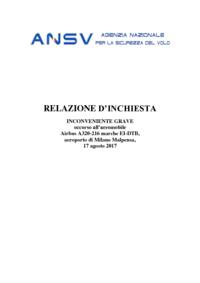
ASN Wikibase Occurrence # 199187
This information is added by users of ASN. Neither ASN nor the Flight Safety Foundation are responsible for the completeness or correctness of this information.
If you feel this information is incomplete or incorrect, you can submit corrected information.
| Date: | Thursday 17 August 2017 |
| Time: | 15:14 UTC |
| Type: |  Airbus A320-216 |
| Owner/operator: | Alitalia |
| Registration: | EI-DTB |
| MSN: | 3815 |
| Year of manufacture: | 2008 |
| Fatalities: | Fatalities: 0 / Occupants: 109 |
| Aircraft damage: | Minor |
| Category: | Serious incident |
| Location: | Milano-Malpensa Airport (MXP/LIMC) -
 Italy Italy
|
| Phase: | Take off |
| Nature: | Passenger - Non-Scheduled/charter/Air Taxi |
| Departure airport: | Milano-Malpensa Airport (MXP/LIMC) |
| Roma-Fiumicino Airport (FCO/LIRF) | |
| Investigating agency: | ANSV |
| Confidence Rating: |
An Airbus A320-216 operated by Alitalia as flight AZ9041, suffered a tail strike during takeoff from runway 35R at Milan-Malpensa Airport, Italy. The takeoff was rejected and the aircraft was taxied back to the apron. The aircraft sustained abrasion damage measuring 1,80m on the rear fuselage and damage to the drain mast.
The flight on which the event occurred was the fourth and last leg of a daily rotation, departing and arriving at Rome-Fiumicino Airport (FCO), Italy. The flight was operated on behalf of a cruise line. The first two legs consisted of a multi-leg flight from FCO to Milan-Maplensa (MXP) and Hamburg, Germany (HAM). The last two legs (third and fourth) consisted of a multi-leg flight HAM-MXP-FCO. At MXP some passengers would disembark, and then on to FCO with the remaining passengers.
The second part of the rotation (third and fourth legs) involved the boarding of 171 passengers at HAM, 68 of which with MXP as destination and 103 with FCO as destination. The handler at HAM pre-accepted the 171 passengers, assigning seats after row 12 to FCO passengers and seats from rows 1 to 12 to MXP passengers; in addition, baggage to be disembarked (3 ULDs) at MPX were placed in the forward cargo hold; this distribution was aimed at facilitating disembarkation and refitting operations at MXP.
Alitalia used specific Loadsheet-software that was not available at HAM since this was not a regular destination for the airline. Instead a copy of the paper loadsheet was sent via e-mail to the airline's load controller at FCO. This load sheet was not designed for a multi-leg flight, so the airline's cargo controller at FCO generated a loadsheet for MXP using the airline's own software, entering a reasonable (but not validated) seating configuration, assuming a homogeneous distribution on board.
After landing at MXP, the passengers in the forward part if the cabin deplaned and the passengers for FCO remained in their seats in rows 13 and up. Thus, the loadsheet prepared for the flight did not reflect the actual weight distribution.
The airplane, EI-DTB, was ferried to Rome-Fiumicino Airport on August 23rd at low altitude (FL100) for repairs.
Causes: the cause of the serious incident is in the area of human/organisational factors. As a result of an inappropriate distribution of passengers on board, a condition of serious imbalance of the aircraft occurred at the beginning of the take-off run.
The following factors contributed to this event
- the infrequency with which multi-leg flights were operated by the company involved in the event;
- the inadequate control procedure of the loading and centering phases due essentially to an insufficient exchange of information between the handlers and the Load Control Office of the operator, also due to the inadequacy, for multi-leg flights, of the form used to communicate the load distribution;
- the flight crew's failure to visually check the actual distribution of passengers on board before takeoff, contrary to what is indicated in the load sheet
- the cabin crew's failure to perceive that the distribution of passengers on board was critical to flight safety. lack of perception by the cabin crew of the actual criticality for flight safety represented by the distribution of passengers.
Accident investigation:
 |
|
Sources:
http://www.ansv.it/It/Detail_relazioni.asp?ID=2063
Similar incident at Veronain 2009: https://aviation-safety.net/database/record.php?id=20090901-0
Revision history:
| Date/time | Contributor | Updates |
|---|---|---|
| 24-Aug-2017 17:12 | harro | Added |
| 24-Aug-2017 17:16 | harro | Updated [Time, Destination airport, Narrative] |
| 15-Apr-2021 13:40 | harro | Updated [Narrative, Accident report] |
| 15-Apr-2021 13:48 | harro | Updated [Time, Total occupants, Damage, Narrative] |
| 15-Apr-2021 17:33 | harro | Updated [Source, Narrative] |
| 15-Apr-2021 18:39 | harro | Updated [Nature] |
Corrections or additions? ... Edit this accident description
The Aviation Safety Network is an exclusive service provided by:


 ©2024 Flight Safety Foundation
©2024 Flight Safety Foundation